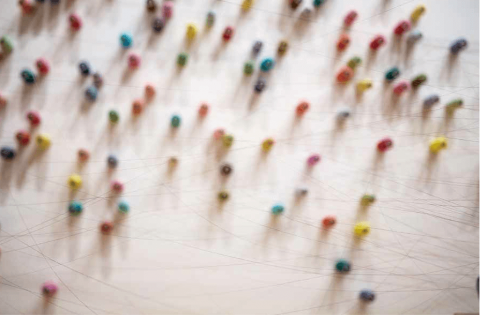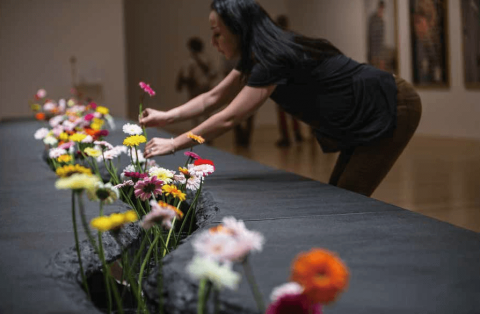Issue:

The Mending Project 
The Moving Garden
Lee Mingwei makes you part of his art
The works of this New York based, Taiwanese artist are all about participation, and his most notorious installations are now on display at the Mori Art Museum
text by JONAS PULVER - photos by MARTIN HLADIK
What if an artwork could leave its location and spread throughout a whole city? What if you could be part of this creative process? Well, it does and you can, with a visit to an exhibition at the Mori Art Museum. It starts with flowers, one of which Taiwanese born artist Lee Mingwei invites you to pick from the black granite vases of his piece, “The Moving Garden.” All he requires in return is a promise that you will offer it to a complete stranger on your trip home.
” says Lee, “but the result is, in fact, very complex. While holding the flower you may start wondering: How should I greet the person I want to give the flower to? What words should I use? Is she going to like it? If you hesitate more than three seconds, the person will probably be gone.” Creation as shared value and generosity, as a way to engage interaction and nurture participation: that’s what Lee’s installations are all about.
“The idea seems quite simple,” says Lee, “but the result is, in fact, very complex. While holding the flower you may start wondering: How should I greet the person I want to give the flower to? What words should I use? Is she going to like it? If you hesitate more than three seconds, the person will probably be gone.” Creation as shared value and generosity, as a way to engage interaction and nurture participation: that’s what Lee’s installations are all about.
The most evocative ones make up the very first large scale retrospective exhibition of the New York based artist, being held at the Mori in Roppongi until Jan. 4. Born in 1964, Lee Mingwei has been attracting international attention since the late 1990s, with works displayed in preeminent American museums as well as at biennales in Venice and Lyon. He admits that the participatory nature of his material makes it challenging for the curators.
“Usually, when a show opens, it is 100 percent complete,” he says. “In my case, however, only 40 percent is set. There are so many moving parts, so much left to uncertainty. It is like an organism that will be awakened by the public.” “The Mending Project,” for instance, consists of a table to which visitors bring pieces of garment (or even their favorite stuffed animal) to be sewed and repaired by the artist himself or a member of the museum team. As work progresses, spools of thread affixed to the walls form a network of colorful, physical and symbolic relations between the museum, the clothes and their owners.
“My works are very much about the viewers. Their history, emotions and memories literally become the content of my pieces,” Lee explains. “Viewers become part of the work, and the use of open ended structure is an invitation for them to do so.”
Unlike conventional paintings or sculptures, Lee Ming wei’s installations do not deliver their essence through their visual dimension. “What you see is not what you get,” he says. “The physical material is only a portal to another experience of reality.” These features climax in works such as “The Dining Project” or “The Sleeping Project,” for which Mingwei eats and even sleeps at the museum with complete strangers, outside opening hours. A lottery box allows you to apply for participation in the performances.
“Eating and sleeping are everyday actions,” says Lee. “However, when they are put in the framework of an institution, it changes their meanings. The fact that the performances can be witnessed by no one challenges the very mechanism of the museum.”
Chance, randomness: Lee Mingwei pushes the envelope that is the legacy of major 20th century art figures such as Yves Klein, Allan Kaprow or John Cage, who deconstructed and questioned the necessity of representation, expression and even intention as constitutive elements of their artistic approach. The Mingwei show cleverly puts into perspective some drawings realized by the inspired fantasist John Cage during a stay in Kyoto; “Where R=Ryoanji” randomly circulates around the 15 stones of the famous zen garden, attesting the attraction for Asian culture among Western artists of the 1960s and 1970s. Interestingly, Lee Mingwei, like John Cage, is an avid reader of the I Ching, the famous Chinese Book of Changes. “Fate, chance and uncertainty define how the world functions,” he believes.
While Asian and Western influences inform Lee Ming wei’s style, he doesn’t consider it relevant to identify with either. “In reviews, Western journalists mainly focus on my proximity with Zen Buddhism,” he says, “while the Asian media talks more about the conceptual, aesthetic dimensions of my practice. I guess both groups exoticize me in a way that makes me understandable for their audience.”
Lee Mingwei has taken the opportunity of his Tokyo show to connect to Japan his grandparents were educated in Tokyo in the 1930s yet it is by no means a discourse on national identity. Instead, it is a device to foster connections, affinities and gift offerings. The installation “Constellation of Water,” commissioned by Mori, consists of two pieces of furniture that belonged to Mingwei’s grandmother.
“There’s a chair and a table on top of a very peaceful grass lawn facing the breathtaking panoramic view of the Tokyo skyline,” he says. “If you sit down, you can drink a glass of water that’s been prepared for you by the previous person.” Past, modernity and transmission: Lee Mingwei sees “Constellation of Water” as an occasion “to consider how we can pursue the adventure of our life. Usually, people walk out of a museum with more answers than when they entered. I would like the visitors to leave my show with more questions.”
And, eventually, with a flower in their hand.
Jonas Pulver is a columnist and freelance journalist for the Swiss newspaper Le Temps and Swiss National Radio Espace 2.

